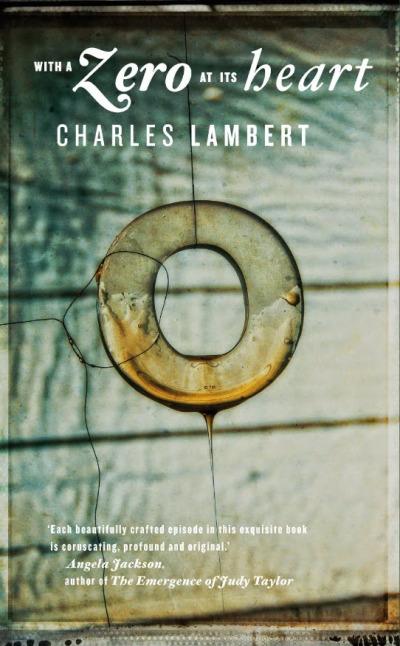 Today’s featured title With a Zero at its Heart was released in May 2014 but I only read it recently, on the recommendation of several friends who predicted I would love it. They were right. My keen interest in narrative structure dates back to my student days, and although this novel in fragments has many qualities over and above its unusual form, it was this topic which I invited author Charles Lambert to explore today. Charles has lived in Italy for many years and is the author of three previous novels – I’m delighted to welcome him to the Literary Sofa (my mini-review follows):
Today’s featured title With a Zero at its Heart was released in May 2014 but I only read it recently, on the recommendation of several friends who predicted I would love it. They were right. My keen interest in narrative structure dates back to my student days, and although this novel in fragments has many qualities over and above its unusual form, it was this topic which I invited author Charles Lambert to explore today. Charles has lived in Italy for many years and is the author of three previous novels – I’m delighted to welcome him to the Literary Sofa (my mini-review follows):
With a Zero at its Heart began as a way of filling in time. I was living with my mother, who was bedridden and slowly dying. I’d been with her for almost eight months, during which time I’d written one novel and revised another, and I had absolutely no idea how much longer I’d be there. I needed to write for several reasons but had no energy, or ideas, for anything large scale. I don’t remember my initial impulse, whether the story came to me before the need to write or vice versa, but I do remember finding myself with a short text, based on a memory of my childhood, and noticing that it was 120 words long. I’ve always been attracted by the idea of working within constraints, as I’ve said elsewhere, and this number seemed serendipitous in a way that encouraged me to write a second piece, linked to the first by theme, also of 120 words. And then, that day or the next, came a third. I decided at that point that I would work in groups, roughly organised by chronological sequence, and that each group would contain ten episodes.
The first theme to be written was Theft and from the start I knew that the main character, the ‘he’, would be both me and not me; that I would have, in other words, room to move into fiction when the text seemed to lead in that direction. I could be as true – and untrue – to the story of myself as I liked. Working in this way made the process both easier and harder. Easier because I suppose I feel that texts, like children, need to know their limits and to work within the security they provide. The format I’d stumbled onto had the double advantage of being constrained and open-ended. I could stop at five or ten, or whatever. Harder because I sometimes had to trim and tinker to make the material fit.
I’d written the first ten themes when my mother died, in June 2011, and it was only when I spoke about what I’d been doing with my agent, Isobel Dixon, and she asked to see what I’d done that the work struck me as one that might have a readership. Several months later, after editors had shown interest but expressed doubts about the fact that it was only 12,000 words (the maths were easy!), she wondered if I’d be prepared to expand the book. My immediate reaction was to say that the text existed because it had met a specific need at a specific moment: the odd, suspended, more or less house-bound and infinitely rich months of my mother’s physical decline. The following day, I sat down to see what might happen if I did, after all, try to continue. I found that I did, after all, have more to say and that the pre-existent structure helped me to say it.

So what began as an exercise in style, in the Oulipian sense, and a time-filler at a time of emotional stress – with these two factors complementing and balancing each other – took on a life of its own and became, almost without my volition, a book. What type of book it is I’m still not sure. It’s autobiographical, but indifferent to accuracy, confessional but, at times, evasive or wilfully incomplete; it ranges from minimally narrated events to riffs on language, art, music. It’s about obsession, and a reflection on obsession. It’s a book that, for all its insistence on loss and ageing, is, I hope, often comic, or startling, and even sexy. What it has in common with life, the actual stuff of it, and with memory is that it doesn’t seem to discriminate between what’s important and what isn’t, and this is one of the ways that the formal constraints that bind the work together come into their own.
Thank you to Charles for writing this lovely piece – even the physical volume is a work of art!
Author photo courtesy of Mario Laporta with thanks.
IN BRIEF: My View of With a Zero at its Heart
The act of reading is an unfolding and there’s no knowing what might be newly held within each fold.
When the above observation appears in the final paragraph it conveys not only a general truth about reading (which is the context) but also captures perfectly the cumulative sense of discovery that takes place in the course of these 24 themed chapters, each with 10 numbered paragraphs of precisely 120 words. It is no small challenge to subject a work of fiction to such rigid constraints but I was amazed how well it worked grouping the fragments by theme, each with an internal chronology of sorts but also an impression of randomness that suggests the surfacing of memories. I found it very satisfying to pick up on echoes between sections and to make my own connections, which everyone would do differently reflecting their personal take on family, friendship, love, loss… The reader cannot detect where real life and fiction merge and it doesn’t matter, for every paragraph evokes something recognisably poignant, amusing, and yes, erotic sometimes. A combination of no holds barred candour and the stellar beauty of Charles Lambert’s prose make this a unique and moving reading experience.
*POSTSCRIPT*
No post next week – I’m taking half term off blogging and writing to spend time with my family and walk some hills in the Peak District. Back on 5 November with a post about my first year as an agented novelist.

